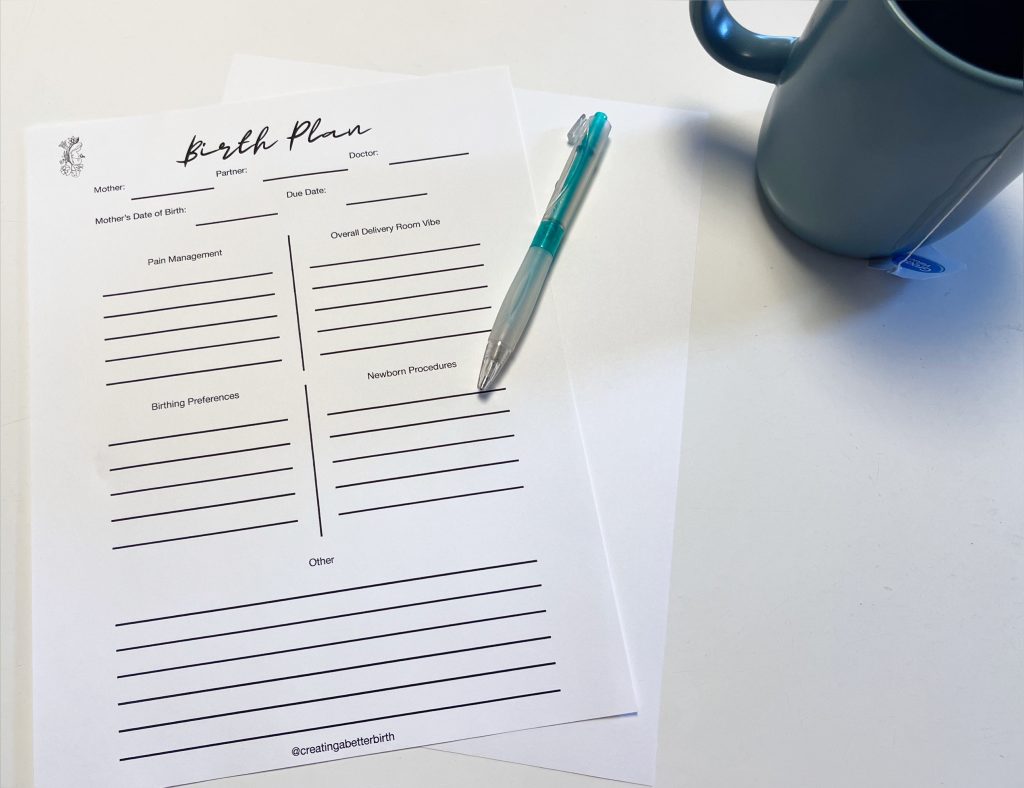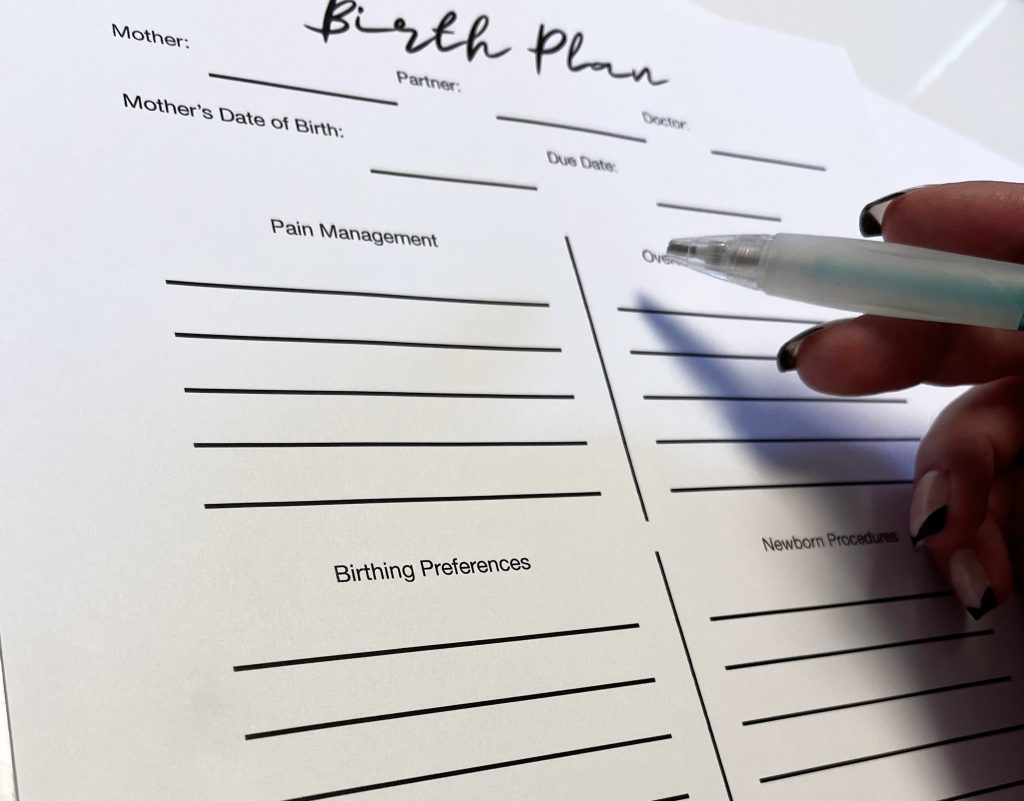
Writing a birth plan can help you lay out your thoughts for your partner, your birth team, and your doctors. As you reach the end of your pregnancy, you begin to think about what you should include in your birth plan. Let’s dive into a few ways it could be written.
What is a birth plan?
A birth plan is a guideline on how you want your birth to be. It includes things such as pain management, the vibe in your delivery room, newborn procedures, birthing preferences, and even religious preferences.
Keep in mind that things don’t always go as planned, so your healthcare team may not be able to fulfill all of your wishes. Having a birth plan written ahead of time as a guide for those around you will enable them to know your preferences and be able to best serve you.
Be sure to be thorough when writing your birth plan. This way, your birth team will know how to react in the case of an unexpected event, such as a C-section or other delivery interventions.
Tips for writing your birth plan
Keep it simple! Many healthcare providers do not have the time to read 17 pages of preferences. There’s typically a lot going on in labor and delivery, so keeping your birth plan to one page can enable others to read it at a glance.
Use bullet points and highlighting so that your birth team can see the important things at a glance.
Use language that is firm, but polite. Be respectful, but make sure that they know that your preferences are the most important. Make instructions and requests clear and easy for your doctor or midwife to read. This will help things go much more smoothly when the time comes.
What to include in your birth plan
Be sure to clearly write your name, due date, and your date of birth at the top of your birth plan. This will allow for less confusion if they store your birth plan in a file.
A few things to consider writing in your birth plan are:
- What kind of delivery you’re planning for
- Whether this is your first, second, third, etc. time giving birth.
- Who your primary support person is. Include their name, phone number, and relation to you in case they need to be contacted. Make sure you also include here any names of people you do or do not want to be present.
- Any medical conditions you have, especially prenatal related issues. Such as anemia, high blood pressure, GBS, STI’s, placenta previa, or gestational diabetes.
- Include the type of environment you want. Be sure to include whether you want music or guided meditations to be played, what kind of atmosphere you desire (lighting, candles, diffusers) and what kind of environment (such as a quiet, calm room or surrounded by family) you want your baby to come into.
- Labor pain management options. Make sure you write whether or not you want an epidural, a spinal block, anesthetic, nitrous oxide, etc. Or whether you would prefer to be completely unmedicated.
- If you prefer to be unmedicated, include what kind of nonmedicated relief options you would like to have. (Such as hydro therapy, aromatherapy, massage, counter pressure, meditation and movement, birthing balls, hot or cold compresses, and breathing techniques.)
- Be sure to let them know if you would like wireless monitoring or intermittent monitoring so that you can use certain birthing positions and move around your room. If you have an epidural, you may need to get creative with birthing positions because you may not have the leg strength for squatting or sitting.
- Birthing positions. The hospital does not allow for very many birthing positions, but there are a few that they do allow. Depending on your doctor or midwife, a few options are: lying on your back, squatting, standing, kneeling, lying on your side, being on all fours, and using a squat bar. Birthing centers are much more accommodating to birthing positions.
(Be sure to ask what is acceptable in that facility before writing your birth plan. This will allow you to decide which options you’d like to try when the time comes.)
Other things to include in your birth plan
When writing your birth plan, you may also want to include:
- Your preferences for delayed cord clamping
- What types of medication’s you do want/want to avoid in the case of an emergency C-section
- Whether or not you would like an episiotomy in any case
- Whether you would consent to a vacuum extraction
- What type of postpartum care you want (including pain medication and stool softeners)
- What options you would like in the case of shoulder dystocia

Examples of what to write for the unexpected
No one wants to think of what could happen when things take a turn for the worst, but this does need to be planned for. In the case of an emergency C-section, there are still some options you can request for your own comfort. These can include:
- Requesting a gentle cesarean
- Having monitoring devices placed out of your field of vision
- Drape options (having the drape lowered so you can see the birth or having a full drape so you have no view of the birth)
- Vaginal seeding (so your baby can still have all the benefits of your microbiome)
- Instructions for newborn skin to skin
Instructions for newborn care
Both hospitals and birthing centers have several routine procedures for newborns. Be sure to educate yourself on these and include them in your birth plan. Include details on:
- Your plans regarding the use of vitamin K
- Vaccinations
- Your babies first bath
- Antibiotic eye ointment
- Whether or not you want them to be wiped off after birth
- PKU testing
- Plans to breast-feed (include giving your baby formula/using donor milk)
- Where the baby will sleep/how often the baby is removed from your room
- Circumcision (if that applies)
- Skin to skin after birth
You and your partner will benefit greatly from educating yourselves and speaking with your chosen pediatrician ahead of time. Make sure you list the baby’s pediatricians information. Include their name, phone number, and clinic name.
Don’t forget to include whether you will be banking your cord blood and your preferences on keeping your placenta or having it disposed of.
Bring your birth plan to one of your doctors appointments and discuss it with them ahead of time so they understand all that you’re hoping for at your birth. Include a print out for your hospital bag and one for the nurses so you’ll definitely have them with you on the big day.
Don’t forget to highlight your main preferences on it for fast reference. That way, if your care provider only has time to glance at it, they’ll easily be able to spot the most important points.
I hope this empowers you to not only plan for the birth you want, but to have the birth you want. Every birth plan will be different, my hope is that yours will be everything that you desire it to be!
Here is a free printable outline to help you write the birth plan that works best for you!
Birth-Plan-PDF Click to Download
Disclaimer: All content and media on the Creating a Better Birth website is created and published online for informational purposes only. It is not intended to be a substitute for professional medical advice and should not be relied on as health or personal advice. Always seek the guidance of a qualified health professional with any questions you may have regarding your health or a medical condition. Never disregard the advice of a medical professional, or delay in seeking it because of something you have read on this Website.
If you think you may have a medical emergency, call your doctor or call emergency services. If you choose to rely on any information provided by Creating a Better Birth, you do so solely at your own risk.
